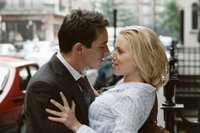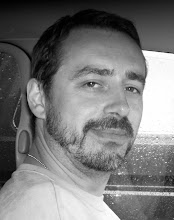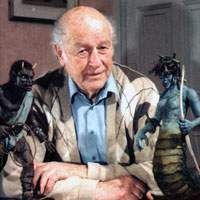 1974 was the year Ray Harryhausen took me on a Golden Voyage, and I was never the same again. Eight years old, huddled in the darkened dream hall of the Studio 1 and 2 in Newport, Wales, thrilling to the fantasy swashbuckling of Captain Sinbad, swinging his heroic blade against a homunculus, a ship’s figurehead come to life, a mystically animated six-armed statue of the goddess Kali, and a one-eyed centaur. If movies are dreaming with your eyes open, then I was ecstatic in the lucidity of a cinematic fever dream, drinking in sights and sounds piped straight from the fertile imagination of the master of such things—Ray Harryhausen.
1974 was the year Ray Harryhausen took me on a Golden Voyage, and I was never the same again. Eight years old, huddled in the darkened dream hall of the Studio 1 and 2 in Newport, Wales, thrilling to the fantasy swashbuckling of Captain Sinbad, swinging his heroic blade against a homunculus, a ship’s figurehead come to life, a mystically animated six-armed statue of the goddess Kali, and a one-eyed centaur. If movies are dreaming with your eyes open, then I was ecstatic in the lucidity of a cinematic fever dream, drinking in sights and sounds piped straight from the fertile imagination of the master of such things—Ray Harryhausen.Strictly speaking, it was not my first introduction to Ray’s work. The chronology is fuzzy in memory, but somewhere around 1973 “Jason and the Argonauts” sailed onto British TV screens and became the focal point of childhood conversation in school playgrounds. The bronze giant Talos, metal head turning to look down at Hercules, stealer of godly artifacts, was the very first of Ray’s stop-motion animation my innocent eyes feasted upon, and I was instantly hooked. These were the days before video and DVD allowed easy repeat viewings, so I drank up every precious second of the film, save the final few scenes. It was late, and my parents sent me off to bed after Jason slayed the hydra, but before the fight with the skeletons who sprang up from the ground where the hydra’s teeth were cast. And so I missed arguably the greatest of all Ray Harryhausen’s stop-motion animation sequences, and the next day had to sit mum, green with envy, as the other kids recounted this sequence in great detail, awestruck. But it didn’t matter; I drank it all up and wanted more.
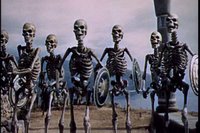 And, these being the days when Ray Harryhausen was still making movies, I got more. The next summer brought “The Golden Voyage of Sinbad” to cinema screens, the second of Ray’s films about the legendary sailor, after Kerwin Matthews battled the Cyclops and fought a duel with a skeleton in “The 7th Voyage of Sinbad” back in 1957, the first of Ray’s films in colour.
And, these being the days when Ray Harryhausen was still making movies, I got more. The next summer brought “The Golden Voyage of Sinbad” to cinema screens, the second of Ray’s films about the legendary sailor, after Kerwin Matthews battled the Cyclops and fought a duel with a skeleton in “The 7th Voyage of Sinbad” back in 1957, the first of Ray’s films in colour. There was a really dull, grown up program on British TV that came on around lunch time. It was essentially a frothy current affairs / general interest type show that my parents had on and found myself watching idly over the remains of lunch. One day, however, the dullness dropped away momentarily as the show featured a short item on a soon-to-be released feature, Sinbad’s aforementioned Golden Voyage. My memory is hard to read on this point, like a faded film print, but I vaguely recall a film clip that featured the fabulous griffin in a prelude to its battle with the evil centaur. Eyes as wide as saucers, imagination firing wildly, I was immediately rapt with trance-like attention. And a few weeks later I was there with my dad, watching the mythic hero’s voyage unfold on the silver screen.
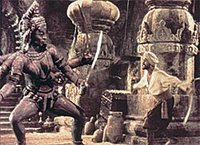 The centerpiece of “The Golden Voyage of Sinbad” is the sequence where the six-armed statue of Kali, reanimated by black magic, sprouts a sword in each hand and launches into a swordfight with Sinbad and his men. Like all of Ray Harryhausen’s greatest work, it is beautifully choreographed. Consider that, for the live action, the actors had to act out the entire swordfight against nothing save a stick for their eyesight line. Then further consider that Ray designed and built the model of Kali and painstakingly animated it to match the trajectory and movements of the actors and their swords. But beyond the impressive creativity, patience, and sheer skill involved in shooting and animating the sequence, it is important to remember that Ray was involved in developing it from the very beginning, from initial idea to concept art to the actual writing. Ray Harryhausen is so much more than a visual effects master; he is an artist, period.
The centerpiece of “The Golden Voyage of Sinbad” is the sequence where the six-armed statue of Kali, reanimated by black magic, sprouts a sword in each hand and launches into a swordfight with Sinbad and his men. Like all of Ray Harryhausen’s greatest work, it is beautifully choreographed. Consider that, for the live action, the actors had to act out the entire swordfight against nothing save a stick for their eyesight line. Then further consider that Ray designed and built the model of Kali and painstakingly animated it to match the trajectory and movements of the actors and their swords. But beyond the impressive creativity, patience, and sheer skill involved in shooting and animating the sequence, it is important to remember that Ray was involved in developing it from the very beginning, from initial idea to concept art to the actual writing. Ray Harryhausen is so much more than a visual effects master; he is an artist, period.Ray had two more doses of monsters, myth, and magic for me to experience in the cinema. 1977 brought “Sinbad and the Eye of the Tiger”, the sailor’s final voyage, upon which I set sail with my grandmother and two cousins at the Odeon in Newport. And four years later I thrilled to the adventures of Perseus in “Clash of the Titans”, which was to be, sadly, Ray’s final film. Cinema had begun to change considerably. George Lucas’ “Star Wars” and “The Empire Strikes Back” had set the celluloid world afire, setting new standards for visual effects and box office blockbusters. Ray’s films were suddenly considered quaint by many, though ironically both of Lucas’ space fantasy epics contained stop-motion animation and the visual effects artists who worked on the films were all inspired by Ray’s work.
As a child, the book that most influenced me was “Horrors—From Screen to Scream”, Ed Naha’s encyclopedic overview of horror, fantasy, and science fiction films. The names of the people behind the films were as familiar to me as pop stars and sports heroes were to other kids--Boris Karloff; Bela Lugosi; James Whale; Jack Pierce; Willis O’Brien; Val Lewton; Peter Cushing; Terence Fisher; Robert Bloch; Richard Matheson. But one name rose above the others: Ray Harryhausen. I read Naha’s book so often that it was all but memorized, and the synopses of Harryhausen’s films lived in my head long before I actually saw the movies.
In the years after Ray’s last film, like a dedicated gumshoe I sought and watched every Harryhausen movie. In the days before videotapes became common, this meant scouring TV guides for showings. One summer, ITV ran a season of films, one every Saturday afternoon. The last film in the season was “Valley of Gwangi”, in which cowboys ventured into a lost valley and came face to face with dinosaurs courtesy of the mind and hands of Ray Harryhausen. Awaiting Gwangi, it turned out to be the longest summer of my life. But it was worth it. The main set piece of “Valley of Gwangi” is the roping of an Allosaurus by several cowboys on horseback. It remains jaw-dropping to this day.
Videotapes were a godsend, though. I finally built up a collection of Ray’s films on VHS tape, later to be replaced by DVD. The last Harryhausen film I caught up with was a laserdisc of “First Men in the Moon”. After that, it has been countless affectionate revisits of the films, including a few on the big screen at repertory theatres, and fascinating readings of Ray’s wonderful book “An Animated Life.”
In 2006, I had the privilege of talking to Ray on the phone, albeit briefly, as part of organizing a virtual appearance by him at the University of Lethbridge. Entitled “Grand Illusions: The Fantasy Worlds of Ray Harryhausen”, the event succeeded beyond my wildest dreams. Terry Gallie, from the Department of New Media at the university and a fellow Harryhausen fan, hosted the event and was similarly awestruck. Terry and I listened in on a media phone interview of Ray, beaming like happy schoolboys. Hearing Ray talk on the phone and live via videolink at the event was a precious memory, and reminded me of the continued fascination and genuine interest Ray and his work still holds.
There is a wonderful, hard-to-define alchemy to a Harryhausen film, but in essence his films port directly to the childlike wonder, awe, and comforting fear inherent within us from the moment we begin to perceive the world around us. Some bury that jeweled box of wonder; others preserve it, and it is those of us who save it that continue our love of Ray’s films into adulthood.
Though Ray Harryhausen retired from making films in 1981, his legacy of pure cinematic magic burns on, even brighter perhaps than in the heyday of his movies. What he has given to me, and millions of moviegoers around the world, is precious: the sense that the world still holds some mystery and awe; belief in the ability of heroes to overcome monsters and the gods themselves; and the understanding that the painstaking, dedicated work of creative individuals can transport us to a better place and lift our souls. Thanks for the memories, Ray; thanks for the dreams; and thanks for the wonder, the yearning of childhood for magic. We need it now more than ever.
Ray Harryhausen: A brief filmography
Mighty Joe Young (1949)
The Beast From 20,000 Fathoms (1953)
It Came From Beneath the Sea (1955)
Earth Vs. the Flying Saucers (1956)
20 Million Miles to Earth (1957)
The Seventh Voyage of Sinbad (1958)
The Three Worlds of Gulliver (1960)
Mysterious Island (1961)
Jason and the Argonauts (1963)
First Men in the Moon (1964)
One Million Years B.C. (1966)
Valley of Gwangi (1969)
The Golden Voyage of Sinbad (1974)
Sinbad and the Eye of the Tiger (1977)
Clash of the Titans (1981)
